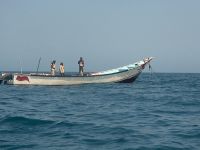Electric Power: Pakistan has 17 gigawatts (GW) of electric generating capacity. Thermal plants make up about 71 percent of this capacity, with hydroelectricity making up 28 percent and nuclear plants 1 percent.
Pakistan's total power generating capacity has increased rapidly in recent years, due largely to foreign investment, leading to a partial alleviation of the power shortages Pakistan had faced earlier. Rotating blackouts ("load shedding") are, however, necessary at times in some areas.
Transmission losses are about 30 percent, due to poor quality infrastructure and a significant amount of power theft. Seasonal reductions affect the availability of hydropower.
With much of the Pakistan's rural areas yet to receive electric power, and less than half of the population connected to the national grid, significant demand growth is expected in the long term, though in the short term, Pakistan has some excess generation capacity.
The electric power sector in Pakistan is still primarily state-owned, but a privatization program is underway. The main state-owned utilities are the Water and Power Development Authority (WAPDA), and the Karachi Electricity Supply Corporation (KESC), which serves only Karachi and surrounding areas.
WAPDA, which is made up of eight regional electricity boards, is to be split up for privatization. One regional entity, the Faisalabad Area Electricity Board, has begun the privatization process. Pakistan set up a National Electric Power Regulatory Authority (NEPRA) in 1997.
Growth in power generation in recent years has come primarily from new independent power producers (IPP's), some of which have been funded by foreign investors.
The two largest private plants are the Hub power company (HUBCO) and the Kot Addu power company. HUBCO is owned by a consortium of National Power (UK), Xenal (Saudi Arabia), and Mitsui Corporation, and has a 1,300-MW capacity.
Kot Addu, with a 1,500-MW capacity, was privatized in 1996 (from WAPDA), and is owned by National Power. Both of these plants, as well as a few other small private operators, sell power to the national grid currently run by WAPDA.
Two power projects involving U.S.-based companies (Babcock and Wilcox, and General Electric) received $293 million from the U.S. Export-Import Bank in early 1998.
These projects involve equipment and services for Uch Power Ltd., and the Saba power plant. Uch Power became operation in December 2000, with a capacity of 550 MW.
Private sector projects will rely primarily on increased use of natural gas and coal. New WAPDA projects are confined to hydropower, including projects such as the 1,425-MW Ghazi-Barotha plant which takes advantage of the enormous untapped potential of the Indus River.
The dam is under construction and is expected to be completed in August 2002. This, along with the oversupply problem, has dampened foreign investor interest in Pakistan's power sector.
IPP's have been involved in disputes and litigation with the government over the rates set in their Power Purchase Agreements (PPA's) with the national WAPDA grid.
The government under Nawaz Sharif had charged that the IPP's had engaged in price fixing and paid bribes to officials of the previous Benazir Bhutto government.
The Sharif government's main demand was for a reduction in rates to 4.5 cents per kilowatt hour (kwh), from the 6.6 cents per kwh which most of the IPPs had in their original contracts.
Both of the largest IPP's, HUBCO and Kot Addu, were targeted, as well as the Malaysian-owned Dharki power plant. In response to the Pakistani government's demands for a rate reduction, the IPP's demanded that prices for fuels be lowered, in particular oil, which is supplied by a state controlled monopoly.
HUBCO's dispute with WAPDA was settled by an agreement on a new price of 5.6 cents per kwh in December 2000, and Kot Addu agreed to a rate reduction in October 2000.
In the short term, Pakistan faces power oversupply. During the period from 1994, when the previous government under Benazir Bhutto announced the policy of promoting foreign investment in the power sector, to the fall of 1995, 33 projects totaling an additional 7,740 MW of capacity were approved.
Demand growth has not yet matched the increases in capacity from new construction.
Power theft is a pressing issue in Pakistan. While it is impossible to precisely measure theft (as opposed to line loss), it is obvious that it constitutes a sizable proportion of Pakistan's overall 30 percent loss rate.
The situation was so severe by early 1999 that the Pakistani government assigned army units to look for illegal connections to transmission lines and rigged meters. By March 1999, the army had lodged 2,439 complaints against power thieves.
Power theft is just one part of the financial problems for WAPDA, however. WAPDA is at the center of a mounting public sector "circular debt," in which state firms and government ministries have failed to pay power bills, and WAPDA has failed to meet obligations to them and to private sector creditors.
Coal:
Coal currently plays a relatively minor role in Pakistan's energy mix, but the discovery of large volumes of low-ash, low-sulfur lignite in the Tharparkar (Thar) Desert in Sindh province could increase its importance.
Thar reserves are being developed under the jurisdiction of the provincial Sindh Coal Authority and have enormous economic potential.
The Authority's policy is to develop the reserves primarily to fuel large electric power plants to be built in tandem with the coal mines.
A feasibility study recently was carried out for the construction of a coal-fired power plant near the Thar coal mines.
Environment:
Pakistan's attempt to raise the living standards of its citizens has meant that economic development has largely taken precedence over environmental issues.
Unchecked use of hazardous chemicals, vehicle emissions, and industrial activity has contributed to a number of environmental and health hazards, chief among them being water pollution.
Much of the country suffers from a lack of potable water due to industrial waste and agricultural runoff that contaminates drinking water supplies.
Poverty and high population growth have aggravated, and to a certain extent, caused, these environmental problems.
Although Pakistan is renowned for its mountain ranges and areas of untouched wilderness, the country passed legislation to protect its environment only in the past 10 years.
Environmental groups have questioned the country's commitment to environmental protection, pointing to the decision in August 1999 to allow oil and gas exploration in Kirthar National Park, the country's oldest national wildlife park, by a multi-national company.
In the cities, widespread use of low-quality fuel, combined with a dramatic expansion in the number of vehicles on Pakistani roads, has led to significant air pollution problems.
Although Pakistan's energy consumption is still low by world standards, lead and carbon emissions are major air pollutants in urban centers such as Karachi, Lahore, and Islamabad.
Theft or diversion of electricity in transmission, as well as a lack of energy efficiency standards, have contributed to Pakistan's high energy and carbon intensities.
To increase energy efficiency, the country is stepping up its use of renewable energy sources to bring electricity to rural areas.
As urbanization continues and the population grows at a rapid rate, in the 21st century Pakistan will need to confront its environmental problems in order to safeguard the health of it citizens.
Energy Overview:
Proven Oil Reserves (1/1/01E): 208 million barrels
Oil Production (1999E): 57,000 barrels per day (bbl/d), of which 53,000 bbl/d was crude oil
Oil Consumption (1999E): 350,000 bbl/d
Net Oil Imports (1999E): 293,000 bbl/d
Crude Oil Refining Capacity (1/1/01E): 238,850 bbl/d
Natural Gas Reserves (1/1/01E): 21.6 trillion cubic feet (Tcf)
Natural Gas Production (1999E): 0.8 Tcf
Natural Gas Consumption (1999E): 0.8 Tcf
Coal Production (1999E): 3.8 million short tons (Mmst)
Coal Consumption (1999E): 4.9 Mmst
Net Coal Imports (1999E): 1.1 Mmst
Recoverable Coal Reserves (12/31/96E): 3.2 billion short tons
Electric Generation Capacity (1/1/99E): 17.0 gigawatts (71 percent thermal, 28 percent hydro, 1 percent nuclear)
Electricity Generation (1999E): 62 billion kilowatthours
Environmental Overview:
Total Energy Consumption (1999E): 1.8 quadrillion Btu (0.5 percent of world total energy consumption)
Energy-Related Carbon Emissions (1999E): 27.9 million metric tons of carbon (0.4 percent of world carbon emissions)
Per Capita Energy Consumption (1999E): 12.5 million Btu (vs. U.S. value of 350.7 million Btu)
Per Capita Carbon Emissions (1999E): 0.2 metric tons of carbon (vs. U.S. value of 5.5 metric tons of carbon)
Energy Intensity (1999E): 31,193 Btu/ $1990 (vs U.S. value of 13,400 Btu/ $1990)
Carbon Intensity (1999E): 0.48 metric tons of carbon/thousand $1990 (vs U.S. value of 0.21 metric tons/thousand $1990)
Sectoral Share of Energy Consumption (1997E): Residential (49.0 percent), Industrial (33.5 percent), Transportation (13.2 percent), Commercial (4.3 percent)
Sectoral Share of Carbon Emissions (1997E): Industrial (45.1 percent), Transportation (27.1 percent), Residential (22.3 percent), Commercial (5.6 percent)
Fuel Share of Energy Consumption (1999E): Oil (41.9 percent), Natural Gas (40.0 percent), Coal (5.0 percent)
Fuel Share of Carbon Emissions (1999E): Oil (54.6 percent), Natural Gas (37.4 percent), Coal (8.0 percent)
Renewable Energy Consumption (1997E): 1,132 trillion Btu (1 percent increase from 1996)
Number of People per Motor Vehicle (1997): 143 (vs. U.S. value of 1.3)
Status in Climate Change Negotiations: Non-Annex I country under the United Nations Framework Convention on Climate Change (ratified June 1st, 1994). Not a signatory to the Kyoto Protocol.
Major Environmental Issues: Water pollution from raw sewage, industrial wastes, and agricultural runoff; limited natural fresh water resources; a majority of the population does not have access to potable water; deforestation; soil erosion and desertification
Major International Environmental Agreements: A party to Conventions on Biodiversity, Climate Change, Desertification, Endangered Species, Environmental Modification, Hazardous Wastes, Law of the Sea, Nuclear Test Ban, Ozone Layer Protection, Ship Pollution and Wetlands. Has signed, but not ratified, Marine Life Conservation .
Energy Industry:
Organization: Oil and Gas Development Corporation (OGDC), a state company, handles oil and gas exploration and development; Water and Power Development Authority (WAPDA) supplies electricity to most of the country; Karachi Electric Supply Corporation Limited (KESC) serves the greater Karachi metropolitan area; Pakistan Atomic Energy Commission (PAEC) operates one nuclear power plant
Major Foreign Energy Company Involvement: AES, Atlantic Richfield, British National Power, Coastal Power, Gaz de France, Total, General Electric, Lasmo Oil (U.K.), Marubeni (Japan), ExxonMobil, Monument Oil & Gas, Premier Oil, Royal Dutch Shell, Xenal (Saudi Arabia)
Major Ports: Gwadar, Karachi, Muhammed bin Qasim, Ormaro
Major Gas Fields: Bhit, Dhodak, Kadanwari, Mari, Prikoh, Qadipur, Sawan, Sui
Major Oil Fields: Dhurnal, Fimkasser, Liari, Mazari, Thora
Major Pipelines: Sui Northern Gas Pipeline; Sui Southern Gas Pipeline; Pak-Arab Refinery Company (PARCO) petroleum product pipeline
Major Refineries (Capacity): Pak-Arab Refinery near Multan (100,000 bbl/d); Attock Refinery in Rawalpindi (35,000 bbl/d), National Refinery in Korangi (62,050 bbl/d), Pakistan Refinery Ltd. in Karachi (46,300 bbl/d)
Source: United States Energy Information Administration.
© 2001 Mena Report (www.menareport.com)







